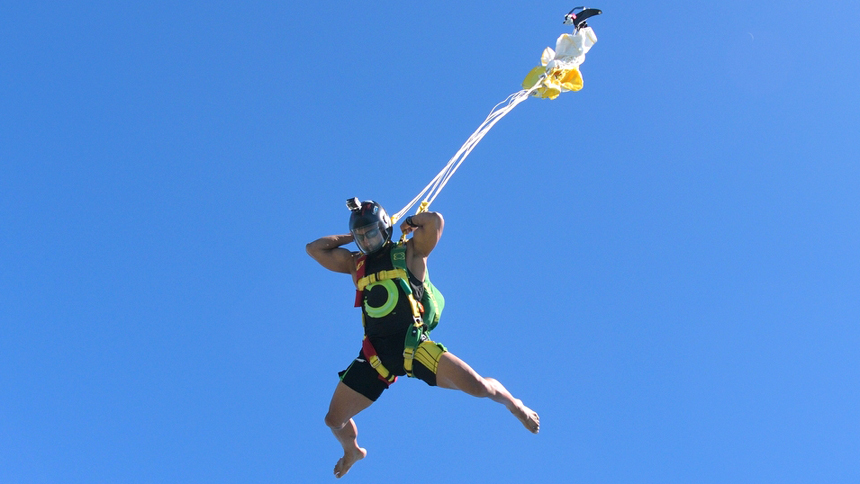3 simple ideas that could save your life Word By DAN BRODSKY CHENFELD
Article by Dan Brodsky-Chenfeld, Manager, Skydive Perris
| [-] Content Index |
|---|
It’s Not Funny
“It is with great sadness that I feel it necessary to bring these skydiving safety issues up again…

Acouple of weeks ago I had two friends tell me that on a jump they looked up at their parachutes, which weren’t working properly, actually heard my voice in their heads telling them to “Cut that crap away!” and cut away immediately. They both landed safely and wrote humorous posts about it.
This past weekend I had two other friends look up at their parachutes which weren’t working properly. One cut away too late, one didn’t cut away at all. We’re very lucky to have one of those of friends still with us. No funny posts this time.
How is this possible?
I’ll tell you. Please, please listen carefully.
Most skydivers, probably you, make these two mistakes first:
- Underestimate the potential risk involved on any given jump
- Overestimate their ability and readiness to handle that risk
Understand this;
SKYDIVING IS NOT A SAFE SPORT. It is a dangerous sport that can be done safely
To do it safely you need to expect everything that can go wrong will go wrong on each jump.
- Expect that something is wrong with your gear when you do a gear check
- Expect to have other jumpers close to you on opening
- Expect your audible and visual altimeters not to work
- Expect to have a hard pull
- Expect to have a malfunction
- Expect other canopies to be coming at you
Many Special Forces soldiers from the US and around the world train at Skydive Perris. They are experts in risk and readiness. All of them practice their EPs every morning for about 10 minutes before jumping. Do you? Are you more prepared than they are? I seriously doubt it.
- How much would you be looking for air traffic if you knew other jumpers were close to you on opening?
- How sharp would you be about altitude awareness if you didn’t have any kind of altimeter?
- How hard would you pull on the first try if you were expecting a hard pull?
- How much would you practice your emergency procedures if you knew you were going to have a malfunction on the next jump?
The Red Bull skydiving team members are close friends of mine who I knew as young jumpers. They do dangerous jumps. I worry about them, but I know they understand and accept the increased risk and they do all they can to prepare for it.
- Do you truly understand the risk?
- Are you prepared for it?
- Are you really?

Be Prepared
Being prepared means anticipating emergencies and having made emergency decisions before the emergency happens. You need to decide NOW that if you ever deploy your main, look up at it and aren’t 100% sure it’s good, you are going to cut away immediately. Bad canopies generally get worse and executing your emergency procedures only becomes more difficult the longer you’re under a spinning malfunction.
Expect a malfunction so you’re not surprised. Being surprised will slow down your response. Take a breath and calmly and immediately execute your EPs.
Be an EPs Badass
Don’t just know your EPs, be great at them!
The first step of any EP is ‘looking’ for your handles. Look first! When you’re under canopy, especially a malfunctioning canopy your handles won’t be in the same place as when you’re wearing your rig on the ground.
Summary
Most skydivers, probably you, make these two mistakes first:
1) Underestimate the potential risk involved on any given jump
2) Overestimate their ability and readiness to handle that risk
Coming to you with much love towards our community and sport, and insane frustration when we’re complacent. Please share.
A Final Word
One more thought on skydiving safety. In case you find yourself under a less than perfect canopy thinking “Maybe I can get out of this….”. Think about this. Other than particular CReW situations, no one in the history of skydiving has ever been hurt or killed because they cut away too soon. Many have been who took too long.
Article by Dan Brodsky-Chenfeld, Manager, Skydive Perris

3 simple ideas that could save your life
Three Simple Lifesavers
- So, you think you’re a Badass?
- How well do you know your emergency procedures?
I’m asking the question because it has become a big issue in the sport. Most skydivers perform their Emergency Procedures (EPs) correctly if asked to demonstrate them. Most can write down the correct answer if taking a written test. But have you trained them to the point of muscle memory? Are the perfect EPs an instinctive response to recognizing a malfunction? If faced with a high pressure, physically strenuous, time sensitive situation are you ready to execute your EPs perfectly and without hesitation? Unfortunately, the honest answer to these questions is too often ‘no’.
Far too many people do not know their emergency procedures anywhere near as well as they need to. As the DZ Manager of one of the world’s largest drop zones, any time I see someone pull too low, or have an AAD fire, I always sit them down and speak to them. Together we try to figure out how they got down there so we can be sure they know what to do differently to be certain it never happens again.
We dirtdive a jump for fifteen minutes but usually don’t practice saving our lives for even 5 seconds
Dan BC
One beautiful, busy day at Skydive Perris we had two Vigil fires within an hour of each other. One of the individuals had about 100 jumps and initiated deployment at 4,000 feet. He had a slow speed malfunction, cut away at a high enough altitude but didn’t pull his reserve before his AAD fired. The other had about 400 jumps, started his deployment at 3000’, had a pilot chute in tow, cut away and went for his reserve but not before his AAD beat him to it.
Since both of them had initiated deployment plenty high there was no reason they should have ended up still in freefall so dangerously low. I asked them to demonstrate their emergency procedures for me. They both did. Then I asked them to talk me through the malfunction, their thought processes and show me what they did.
Neither of them executed their emergency procedures correctly!
They both did something different in the air than the intended emergency procedures they had just shown me! One of them ‘reached’ before he ‘looked’. The other reached with one hand when his plan was to have both hands on both handles.
How is that possible?
Skydiving equipment has advanced so much. The emergency procedures we have to do when faced with a malfunction are simple and easy to execute. Way too many fatalities – and more close calls than we can even count – happen because we don’t perform these procedures correctly within the time we have.

These three simple ideas could save your life:
1. Practice your EPs
Emergency procedures are not practiced enough. I’ve asked many people how often they practice their EPs. The most common answer I hear is “I practice them before each jump.” That sounds like it should be plenty but the fact is, it’s not. Based on that, the jumper with 100 jumps had practiced EPs a total of 100 times. That is not nearly enough to develop the instinctive muscle memory you will need to save your life in the few seconds you have.
There are a few different ways to execute emergency procedures. Each one of them will work as long as you perform it correctly and immediately. None of them take more than five seconds. In a minute you could practice your EPs 12 times. Since your life depends on it, why not take five minutes each day and go through your EPs 60 times. We dirtdive a jump for 15 minutes but usually don’t practice saving our lives for even 5 seconds
Do your EPs ten times a day for 30 seconds, or five times a day each for a minute. But somewhere in your day find five minutes you can dedicate to practicing EPs (every day, not just jumping days) and you will have rehearsed them to the point that they are totally automatic. You’ll see a malfunction and will instinctively perform the perfect procedures without hesitation.
- You want to be a Badass?
- Be a badass at performing your EPs

Image by Norman Kent
2. Stay one step ahead
We are too often surprised when our parachutes don’t work correctly and take too long to make the decision to cut away. Stay one step ahead. Expect your parachute to malfunction every jump. Be pleasantly surprised when it doesn’t. If you have any doubt at all about whether your parachute is good or not, it’s not. A good parachute doesn’t give you any doubt.
Decide right now that if you aren’t 100% sure you have a good canopy over your head you will cut away without hesitation
Don’t wait until you are faced with a stressful malfunction situation to decide what you are going to do. Decide right now that if you aren’t 100% sure you have a good canopy over your head you will cut away without hesitation.

3. Pull at a safe altitude
If you don’t have enough altitude even well executed EPs won’t save you. USPA’s minimum deployment altitude is 2,500 feet. To deploy by 2,500 feet you need to be waving off no lower than 3000 feet. If you are lower you may not have the time you’ll need.
These three simple ideas could save your life. They’ve saved mine on more than 30 malfunctions. Please consider them and share them.




